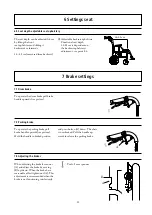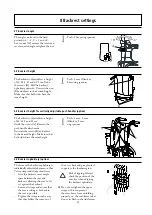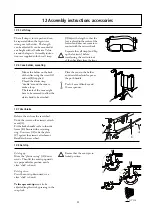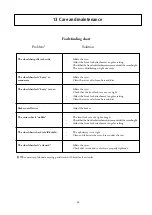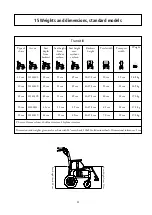
11
Tools: 6 mm Allen key
(a spirit level if necessary)
(!) Keep your eye on
something vertical,
e.g. a door frame or table leg
while setting the angle.
6 Settings seat
B
A
A
B
6:1 Front seat height
The front seat height is 51 cm.
The rear seat height is 49 cm.
Front wheel
8” allround
Front fork
with steel axle
Rear wheel
16” pneumatic
6:3 Changing front fork
Unscrew the protective stopper on
the front fork attachment to reach
the retaining nut. Unscrew the nut
and pull out the front fork. Take the
washer and ball bearings and put it
on the new fork (the bevelled side
(A) towards the fork). It is important
to ensure that the washers in the
attachment (under the retaining nut)
are placed in the right order, with the
spring washer (B) on top.
Tighten the retaining nut until it
cannot be turned any more. Then
loosen it
½-1 turn. The spring washer then has
the correct tension. It reduces the risk
of the castor starting to ”wobble”.
Tools: 19 mm box spanner
and Phillips screwdriver
6:4 Setting the angle of the front fork attachment
The correct angle setting is important
for the wheelchair’s manoeuvrability.
- Loosen the lower attachment
screw (A) about 2 turns so that
the tag (C) moves freely inside
the shaft. Insert the Allen key in
the hole (B) and turn until the
attachment is perpendicular to
the floor. Always start from a
position that enables the wheel
to move forward in the rotation
(D). Hold the shaft in place while
the lower attachment screw is
tightened.
C
D
20Nm
The height of the front fork can
be adjusted 4 cm up or down by
loosening the two attachment screws
(A and B) 1-2 turns. See position
marking (C) to obtain equal height on
both sides.
Check and adjust the angle of the
attachment and tighten the screws.
Tools: 6 mm Allen key
(a spirit level might be
useful).
Risk of tipping: Always
check the setting of the the
anti-tips.
(!)
Also adjust the angle of the
front fork attachment, see
point 6:4.
A
B
C
6:2 Adjusting the height of the front fork attachment
20Nm












